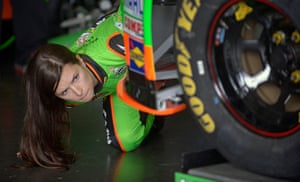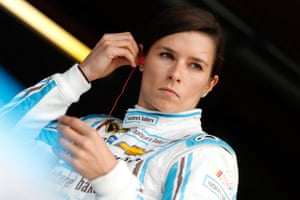The Hollywood treatment of the Danica Patrick story hasn’t hit theaters yet. But please believe: it’s coming. Maybe in a year. Maybe in 30. Either way, the creative license is going to be off the charts.
It’s not hard to imagine the Danica character, played by a Mara sister or similar “type”, shaving her head or adding bass to her voice or insisting her rival drivers call her “Dan Patrick”. The idea of a woman race car driver – and inside the southern fried, patriarchal world of Nascar of all places – requires so much suspension of disbelief, after all. The most palatable argument for it isn’t the truth. It’s another version of Disney’s Mulan, but with a fiery race car in place of a dragon.
Never mind that she’s still driving that race car, although who knows for how much longer. In a Facebook statement posted last week the 35-year-old Patrick announced that this year would be her last driving for Stewart-Haas Racing, a perennial championship stalker in Nascar’s top level; more than six years ago, in a crossover coup, the team lured her away from IndyCar – the Formula One facsimile where she’d emerge as the most successful woman in the history of American open-wheel racing and a ubiquitous celebrity to boot.
Publicly, both parties say this breakup is mutual. But anyone with a basic understanding of contract law well knows what an employer means to say when it decides against renewing an expiring agreement: basically, you’re fired. Surely team co-owner Tony Stewart was being ironic when he called his support for Patrick “unwavering”.
In the case of this particular dismissal, however, there’s cause. And it’s not exclusively related to Patrick’s on-track performance, even though that concern dates to her days steering open-wheel machines in the IndyCar series. And while she certainly enjoyed her share of gender firsts – leading 19 laps of the 2005 Indianapolis 500, finishing third in ’09, actually winning a race in Japan the year prior – she didn’t enjoy nearly enough of them to recommend a transition to Nascar, where cars can seem unruly to even the most skilled pilots. Juan Pablo Montoya, a preternatural talent with seven Formula One wins and a pair of Indy’s Borg Warner trophies to his name, spent nine years in Nascar’s top series and only won twice. The highlight of him crashing into a jet dryer truck at the 2012 Daytona 500 will forever live in infamy.
Incidentally, that race also marked Patrick’s debut in Sprint Cup, Nascar’s top flight. And while that outing didn’t go as planned (she finished 38th among 43 drivers), it was quickly reframed as a character-building experience after she earned the pole position in the race the very next year.

That, too, was an explosive moment – one Patrick does not hesitate to herald in her Facebook statement, along with seven top-10 finishes. (A note for the next boast: maybe nod to the little seat time missed in more than 300 appearances?) No doubt it’s been an impressive run – especially for someone whose formative racing experience traces to Milton Keynes, where a teenage Patrick once competed in British national series events against the likes of future F1 champion Jenson Button.
Still: you don’t have to look hard to find the Nascar fan who says that if “Dan Patrick” were responsible for the same production, he wouldn’t have been able to drive for a frontrunner like Stewart-Haas if he would be able to drive in Nascar at all. And that’s true. It’s also true that if she were winning races in bunches, like Jeff Gordon and Jimmie Johnson, the shrinking audience for Nascar might be even smaller. (Menfolk are full of empathy for a damsel in distress. But a boss? She’s a bitch.)
It’s also true that the trailblazer’s road is the roughest and loneliest. That much was clear the day I wandered into her garage while covering a 2014 test session at Michigan. Off to one side were a dozen or so boffins, poring over telemetry data. Opposite them was Patrick, sitting by herself, on her phone, scrolling. Before then I thought I knew from loneliness in Nascar, being one of the few black writers who covers the beat. But that scene always comes back, usually when some barfly is droning on about how Patrick has no business operating a race car. It left me wondering how differently things might’ve turned out for her had there been even one other woman among her technical advisors. Likely in that alternative reading, Patrick gets credit for two revolutions: the one Patrick started inside the car and the pit box.
Patrick’s saving grace, of course, was self-promotion. She didn’t just sign die casts models or hawk motor oil. She posed for Sports Illustrated’s swimsuit issue and starred in racy Super Bowl ads. She was the anti-Mulan – the rare sports woman who infiltrates, and thrives, in an exclusively male preserve while accentuating every bit of her womanhood. No, the marketing strategy isn’t for everyone. But Patrick made it pay off to the tune of tens of millions of dollars in endorsements. And to her credit, she’s never been much of a prude about how that money gets made, a trait that further distinguishes her from the cheesecake athlete who came before – Anna Kournikova, say.
Patrick would collect many patrons in her day, but none that quite approached the generosity of GoDaddy; for ages the web domain purveyor seemed to support Patrick’s racing exploits without giving a second thought to the staggering expense. When the company finally decided, in the spring of 2015, to completely withdraw its underwriting relationship with Nascar, there was a palpable sense that Patrick would suffer the worst. Now she’d be forced to go out and actually fundraise. And, well, those efforts haven’t unfolded as scripted either.

A 2016 partnership with Nature’s Bakery seemed like progress, not least because they were Nascar newbies. But then earlier this year the company abruptly pulled support, citing, among other things, her blatant promotion of competing products. (After trading lawsuits, Stewart-Haas and Nature’s Bakery settled out of court.) Soon thereafter, Smithfield Foods, a Virginia-headquartered meat processing concern, announced plans to begin subsidizing Stewart-Haas next year. But unlike Nature’s Bakery, they aren’t new to this game. In fact, they’ve been sponsoring Aric Almirola, another diversity test case who drives for a team fronted by Nascar legend Richard Petty, for some years now and he could very well convey in the deal. That leaves Patrick as the odd woman out. Familiar territory, then.
Where she lands next is anyone’s guess. The most appealing open seats on the grid have already been promised to a handful of younger, cheaper talents who owe their career breaks to the procession of retiring Nascar stars. Two years ago it was Gordon. Last year it was Tony Stewart and Carl Edwards. Up next is Dale Earnhardt Jr, with Patrick potentially out the door with him. If you didn’t have a reason to tune in the last nine weeks of the Nascar season before, certainly you do now.
If Patrick never races again, it won’t be a tragedy. She’s far richer than all of her women driver forebears put together. What’s more, she’s already laid enough groundwork, between Instagram photos of yoga routines and meatless meals, to position her as a health and wellness ambassador in the Jillian Michaels mold. She’s likely to maintain a presence around the track too, whether that’s as the trophy girlfriend of Ricky Stenhouse Jr – an ascendant example from that aforementioned younger, cheaper driver cohort – or as a broadcast analyst, which would represent yet another mind-blowing feat.
And that, right there, is the beauty of Danica Patrick: she’s an instrument of male and female fantasy, the sports pinup who grinds harder for feminism, day-to-day, than the great Billie Jean King ever could. It’s a story almost too good to be true. In the fullness of time, we’ll see if history, or Hollywood, remembers it that way.



